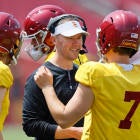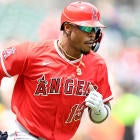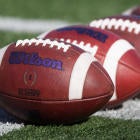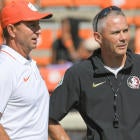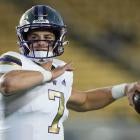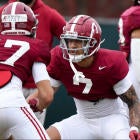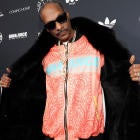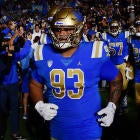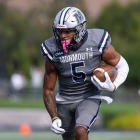
We often mock what we don't understand, and that's exactly what most of the media did back in May 2001, when the University of Oregon made one very curious move.
The Ducks' brass had the idea to put up a 10-story billboard in midtown Manhattan touting star quarterback Joey Harrington -- and, more important, Ducks football -- to the world.
Jim Bartko, a longtime Oregon athletic department employee working in development who has been there since 1988 -- dating to a time when the Ducks hadn't made a bowl game in 33 seasons -- was in Manhattan for the unveiling of the "Joey Heisman" billboard and an accompanying press tour to the Today Show, Sports Illustrated and ESPN The Magazine.
"I just remember standing behind some Wall Street guy wearing his suit and tie and hearing him say, 'What's an Oregon?'"
The media shredded Oregon's bold marketing move, as if offended that the Ducks, a program that had made it to one Rose Bowl in the previous 43 years, had the gall to put themselves out there like that.
Turns out, just like the Ducks' wild uniforms, the ploy was genius.
"Back then, our tradition wasn't like it is at a lot of places. We said, 'It is going to be innovative, and let's be different,'" Bartko said.
"We had a combination of things work in our favor that year: We had a great team, a great coach [Mike Bellotti], a great student-athlete [Harrington] and we had some luck. We won a lot of close games that year. We could've gone 5-6 that season and looked awfully dumb."
Bartko's right. The Ducks won five games by a touchdown or less in 2001 en route to an 11-1 record and a No. 2 finish in the polls while Harrington became a Heisman finalist. That helped rally a fan base for the school's move the following season into a modernized version of Autzen Stadium with 15,000 more seats and 32 more skyboxes, underscoring the fact that Oregon was no longer just a "regional" program.
The billboard and the magical season gave the Oregon program the momentum that changed the school, sowing the seeds for an athletic powerhouse, not just in football. The Ducks' national rise to the elite level is reflected here by its ranking at No. 2 in CBS Sports' "Best of College Sports" series. Pound for pound, no athletic department is better these days than Oregon's. The Ducks just wrapped up their fourth top-25 finish in five years in the Directors Cup and bested every other school with 18 or fewer NCAA sports for the sixth consecutive year.
| Best in College Sports: No. 2 Oregon |
||
| Category | Pts | |
| Football | 270 | |
| Men's BB | 128 | |
| Women's BB | 0 | |
| Baseball | 50 | |
| WC (Softball) | 64 | |
| Total | 512 | |
| WC - wild card sport | ||
As much as the football team gets all the headlines (Oregon has been to four consecutive BCS bowls and ranked no lower than No. 4 the past three seasons), Oregon does have a rich history, having been known as "Track Town USA" for years with Hayward Field being the mecca of the sport. Embracing speed, in retrospect, seems like a perfect fit.
Still, at the root of the Ducks' rise has been one shrewd move after another to mold Oregon into "the cool school," and it was far from an overnight process.
In 1996, only an hour after the Ducks were throttled by Colorado 38-6 in the Cotton Bowl, Nike CEO Phil Knight, an Oregon grad and former middle-distance runner on its track team, had a meeting with a few of the school's biggest boosters and Bellotti. He asked the coach, "How can we help make Oregon better?"
Bellotti told the Oregon power brokers that he needed an indoor practice facility to combat the Pacific Northwest weather.
"We raised about $10 million that night," recalled Bartko, "and nine months later, the Moshofsky Center was built."
The Ducks had the Pac-10's first indoor practice facility and also, thanks to some of Nike's best designers, were in the process of revamping their image, starting with the now-iconic Oregon "O" and a shift to a more aggressive color scheme, morphing to dark green, yellow and black. The Ducks also opted to change their uniforms every three years, giving the players and coaches input, ideas a lot of head football coaches would've balked at.
The school went all in, with "cutting edge" thinking that matches Nike's high-tech looking gear with a frenetic football style of a fast-paced attack on the field. It's why Oregon can now pluck five-star speedsters like De'Anthony Thomas right out of Southern Cal's backyard and bring him up to the Pacific Northwest.
"It's about Nike innovation that picks up on the style of play, the pace and how we prepare, and it's carried over," Oregon athletic director Rob Mullens said. "It's very well thought out. They have the brightest minds in innovation and creativity, and they're always willing to say, 'Let's be first.' And now everybody else is trying to imitate it."
There is no more buzzworthy program than Oregon these days. Everyone in sports now keeps an eye on what the Ducks have or are doing. Earlier this month, a couple of star QBs, Clemson's Tajh Boyd and Michigan's Devin Gardner -- two guys from traditional football powerhouses -- toured Oregon's facilities and had their chins on the floor, marveling at everything from Oregon's posh rehab and recovery center to the Ducks' "liquid metal" helmets.
Mullens smiled when he heard about the players' reaction. He was quick to point out that they didn't even get to see the Jaqua Academic Center, Oregon's $42 million, 40,000-square-foot center for its athletes that has served as a great unifier, connecting all the sports and fostering what they feel is a pretty unique spirit around Eugene.
"People stepped up. We built a brand. We got lucky, and it snowballed now to the rest of our whole department," Bartko said. "Back then, you didn't think [about these ideas] not working. When you're doing it and you're having so much fun, you don't think about failing.
"I do wish they [deceased Oregon boosters Randy Pape and Ed Moshofsky] could've all enjoyed seeing their vision become a reality. They stepped up when it wasn't cool to do it."











